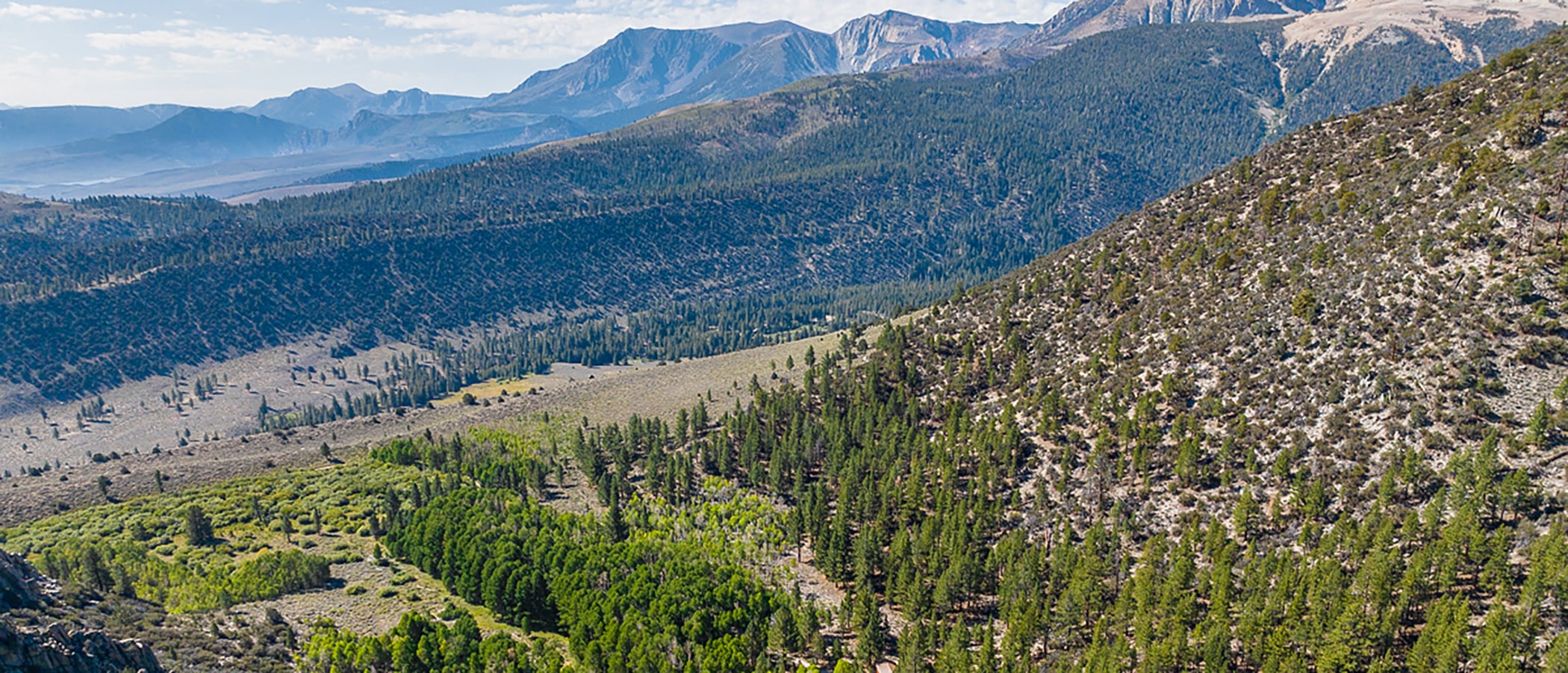
In the spring, the Mono Lake Kootzaduka’a Tribe finalized the purchase of Tupe Nobe, land formerly known as Burger’s Sierra Retreat. Located on the Tribe’s ancestral homelands, this land sits ten miles east of Yosemite National Park and five miles west of Mono Lake. The purchase returns 160 acres of land back to its original stewards.
Tupe Nobe translates to “the rock house” and refers to the mountain in the middle of the property. The land encompasses several diverse and important habitats—wet meadows, aspen forest, riparian and upland habitats. The parcel is a small piece of the larger region where the Kootzaduka’a Tribe has lived since time immemorial. Starting in the 1860s, settlers divided this land into plots and took it from Kootzaduka’a people. Tupe Nobe was one of those parcels, and now its return to the Tribe is a significant step in the “land back” movement.
Learn more about Tupe Nobe at this interactive StoryMap
Now at Tupe Nobe, the Tribe is carrying on their legacy of conservation and Tribal stewardship. They are working to sustain Kootzaduka’a culture, memory and traditions with the resources and opportunities that this land provides. The Mono Lake Committee supported the Tribe and grant partners through the acquisition process and celebrated the completion of the land transfer, a step in both reconciliation for the Kootzaduka’a Tribe and also protection of this important land.
Some history of Tupe Nobe
The Kootzaduka’a people did not demarcate land with boundaries or see it as a commodity to be owned. In their words, “We as Kootzaduka’a people see boundary lines as impossible demarcations of a landscape … to try to divide landscapes is like trying to divide the air we breathe or the water we drink.”
However, when white settlers discovered gold in the area, demand for agricultural production and other amenities began to rise. The Kootzaduka’a chapter in the book Voices of the People recounts: “Many ranchers moved to the Mono Lake area. In doing so, they displaced the Kootzaduka’a from their camps and gathering places.” Backed by federal laws, settlers divided, claimed, and took ownership of Kootzaduka’a territory. However, Kootzaduka’a land remains technically unceded because the Tribe never signed a treaty or gave up their land in another legal way.
One important point in this story was the passage of the Homestead Act of 1862, which encouraged settlers in western territories to claim 160-acre land parcels with the condition they would live there and cultivate the land.
It was in this context that the first documented owner of Tupe Nobe purchased it in 1881. After that, the land was passed down or sold to eight different, successive people. In 1943, the Burger family purchased the land, and established Burger’s Sierra Retreat as a wildlife sanctuary.
Two generations of the Burger family established a legacy of environmental conservation on the property. Dale Burger, known for his hands-on care for the property over decades, even established a conservation easement for the land to ensure lasting protection.
When the Burger family decided to sell the property, continued care for the land was the top concern. Dale shared that he and the family are proud and excited that the Tribe will now take care of the land. “I wanted someone who would respect the property, cherish it, maintain it, share it,” he said. “And wow. I got all of that with the Tribe … of all the possible buyers, I could not think of a better one. These are people who cherished the land before we even got there. And that’s what I want for that property.”
Work and plans at Tupe Nobe
The Kootzaduka’a Tribe acquired the land in part through a grant from the Sierra Nevada Conservancy, working closely with the Eastern Sierra Land Trust to successfully apply. After finalizing the purchase in the spring, the Tribe began work on the land and structures there, improving and preparing them for use. This included cleaning cabins, installing new floors, and adding a water storage tank for fire safety.
All of this work is setting the Tribe up to continue forward with their priority plans for the land, which center around stewarding and protecting the land, using Kootzaduka’a traditional practices, and building capacity for the Tribe. These goals go hand in hand, as the Tribe described in a 2023 proposal—they are “tried and true traditional stewardship practices that have served the Tribe and the landscape well for millennia.”
This ongoing work includes developing and using “nature-based solutions to climate change impacts.” The Tribe will establish a Tribally led conservation crew that will “work toward restoring landscape resilience,” maintain and steward the land, protect the critical habitat it provides for many species, and help run educational programs and camps to share the area with visitors.
Because Tupe Nobe is particularly vulnerable to fire, the Tribe is also prioritizing removing dead wood and other fire starters. They also applied for a grant through the California EPA’s Environmental Justice Action Program to bolster this work.
The Tribe also shares that Tupe Nobe will be important as a place for ceremonies and cultural events. This land provides vital space to keep traditions alive.
Caelen McQuilkin wrote this post in collaboration and with approval from members of the Mono Lake Kootzaduka’a Tribe. This post was also published as an article in the Fall 2025 Mono Lake Newsletter. Top photo courtesy of Nolan Nitschke/Eastern Sierra Land Trust.
